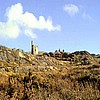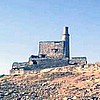Copper Mining in Allihies
Mining during the 19th and 20th century  The
Berehaven copper mines overlook the picturesque village of Allihies and Ballydonegan
Bay at the western end of the Beara Peninsula in West Cork. The tall chimney
shaped ruins is a constant reminder to the community of busier days that are
gone. For three quarters of the last century this area was the site of great
industry. Up to 1500 mineworkers and their families lived and toiled here,
to exploit the largest copper mine in Ireland's history. Giving a population
of more than 6000 to the parish at that time!
The
Berehaven copper mines overlook the picturesque village of Allihies and Ballydonegan
Bay at the western end of the Beara Peninsula in West Cork. The tall chimney
shaped ruins is a constant reminder to the community of busier days that are
gone. For three quarters of the last century this area was the site of great
industry. Up to 1500 mineworkers and their families lived and toiled here,
to exploit the largest copper mine in Ireland's history. Giving a population
of more than 6000 to the parish at that time!
Nineteenth century mining was begun in 1812 by "Copper" John Puxley of Dunboy Castle, Castletownberehaven, one of four partners in the Allihies Mining Company. Puxley became sole owner in 1842 when he reformed the company as the Bearhaven Mining Company. Copper John died in 1856, leaving the company to his eldest grandson, John. On his death in 1860 the mines passed to his brother Henry who sold them off in 1868.
There is a book written by Daphne Du Maurier based on the tragic family history of the Puxley's called "Hungry Hill". Even though it is written as fiction, it gives a realistic account of the problems and hardship of the times. (Go to books page here... )
The mines continued to operate until 1884 under the owners to the Berehaven Mining Company but without profit. There were six productive mines of which the Mountain Mine on the north side of the village was the most productive one.
The transportation of the copper from the mine always presented a problem and hampered full exploitation of the resources. At first the ore was carried by schooners from Ballydonegan pier but because of the danger involved in bringing vessels such as these into Ballydonegan the ore was later brought by horse and cart to Castletownbere to be shipped to Swansea.
It is said that they were once the most prosperous mines in Ireland. However, a decline set in around 1850. Conditions for the workers, never very good became more intolerable and so we find more and more of the local mines setting sail for the mining towns in America, particularly to Butte, Montana.
After that a pattern began of mine closures and new companies forming to take over. This trend continued and by the 1930's the deepest shaft was 1800 foot into the hill and a total of almost 30,000 tons of pure copper exported.
The last time the mine opened was in 1956. This time drilling went to a depth of 2600 feet. Electricity and new machinery brought welcome changes to the lives of the miners. However, the Allihies copper mines closed for the last time in 1962
Even during the time when Allihies Copper Mines prospered, the ordinary workers saw little of the benefits of such prosperity. Their lot was deplorable. Working conditions were dangerous and unhealthy and were the cause of various lung diseases. Wages were low and the local workers and their families (in a lot of cases wife and children also worked in the mines crushing the stones) lived in poverty.
In the early years a group of Cornish miners were brought to Allihies because they had more experience than the local people. These Cornish people came with their families and built up their own village community in the hills near the mine. There they lived in comfort as Puxley paid for most of their expenses like rent, fuel, candles and he provided a school and teacher for the Cornish children. One family still remain in the village to this day that claim descent from the Cornish mining families.
A fine 1862 Man Engine House still stands but is in dire need of repair.
The Heritage Society of Ireland has launched an appeal for funding to allow
it to do the necessary repairs to stop it from collapsing and to preserve
it for future generations, as it is the only Man Engine House still standing
in Europe.
More about the preservation of the Man Engine... 
Also the remains of another engine house are visible to the East of the parish. The early opencast works are still obvious, with the ruined Cornish Village (one house rebuilt). A fine gunpowder magazine is preserved in a rocky hollow below the Cornish Village. Below the Man Engine House are ore dressing floors and the foundations of various early 20th century mine buildings.
The mines were bought to the attention of the world in 1943 through Daphne du Maurier's novel " Hungry Hill", and again in 1946 when the book was filmed. A full mining and social history of the area is available in Alan Williams excellent and highly readable book "The Berehaven Copper Mines". The Geological Survey has also published a short pamphlet guide, "The geology of Allihies Mines, desert, rivers, slate mountains and copper ore" by Daniel Tietzch-Tyler.
Follow this link to see more about local efforts to build a mine museum [here...]